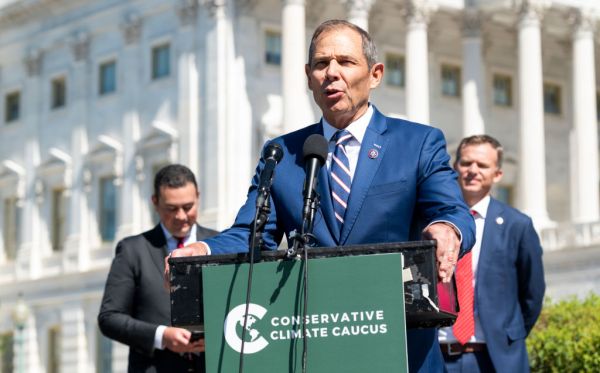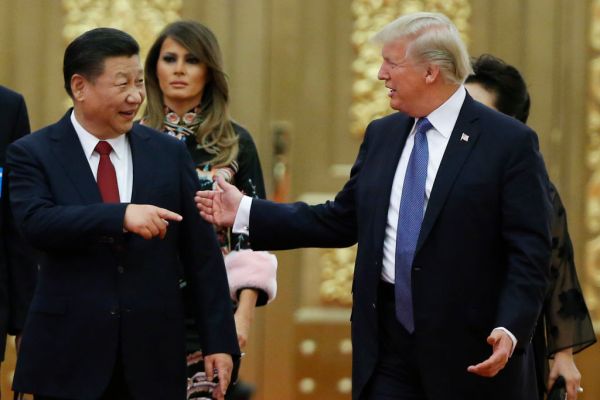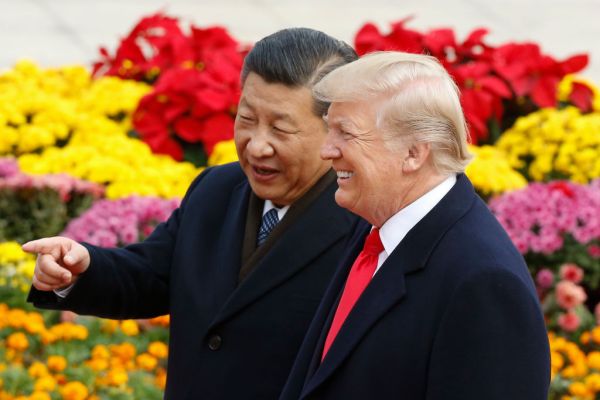A bipartisan group of senators this week introduced the PROVE IT Act, which would direct the Department of Energy to study “the emissions intensity of certain goods produced in the United States to the emissions of those same goods” produced in other countries. That might sound abstruse, but Republican Sen. Kevin Cramer and Democratic Sen. Chris Coons see the legislation as a necessary precursor to “addressing climate through trade policy.”
Supporters argue that the bill lays the groundwork for legislation that lowers carbon dioxide emissions and boosts the competitiveness of American manufacturing. Skeptics worry that so-called “green protectionism” won’t accomplish either of those goals.
What’s in the bill, and what does its existence say about the evolution of climate change politics?
PROVE IT as a precursor.
The philosophy behind the PROVE IT Act is simple: Greenhouse gas emissions are costly, and those costs should be better accounted for in international trade. The mandated DOE study would measure the amount of carbon dioxide and other greenhouse gases associated with billions of dollars worth of products—including iron, steel, cement, plastic, and aluminum, as well as biofuels, solar panels, and wind turbines.
Plenty of toothless bills commissioning studies come out of Capitol Hill, but there’s reason to think this one could actually make a difference. The U.S. has gathered data on emissions at the facility, company, and industry level for years. Yet the extensive product-level information required in the bill would be new. And it’s what lawmakers would need in hand if they wanted to use trade policy to influence carbon emissions.
There are two ways Congress could go about doing that. The first would be a carbon border adjustment mechanism, which would place a tax on imports and a rebate on exports. For the sake of fairness and simplicity, that border adjustment would be tied to a domestic carbon tax or cap-and-trade system, providing a financial incentive for all the companies (and countries) involved in the trade to reduce their carbon footprint.
More likely, however, would be a simple tariff on carbon emissions. While a true border adjustment mechanism would include an import tax and an export rebate—along the lines of what the U.S. already does for alcohol and tobacco—a tariff would apply only to imports.
Several senators, Republican and Democratic, have expressed interest in a tariff. And the PROVE IT Act is structured around the United States’ Harmonized Tariff Schedule, which Cato Institute policy analyst Gabriella Beaumont‐Smith sees as “a pretty bold indication that there’s a plan to implement some kind of carbon tariff.”
“It’s heartening that policymakers realize that we can’t rely on country industry-level emissions anymore,” Shuting Pomerleau, a research manager at the Niskanen Center, tells The Dispatch. “We need to get down to the product level if we want to address climate and trade across borders.”
Following the European Union.
The introduction of the Cramer-Coons bill comes months after the European Union finalized a new suite of climate policies named “Fit for 55.” Built on Europe’s pre-existing cap-and-trade system, the legislation is designed to help the EU reach a goal of a 55 percent reduction in 1990-level greenhouse gas emissions by 2030. EU policymakers say that the package includes a carbon border adjustment mechanism—but Pomerleau suggests that it’s more of a pure tariff because it lacks an export rebate.
In October, companies across the world that import products to the EU must begin accounting for the carbon emissions of their products, reporting similar data to what the Cramer-Coons bill would require. In 2026, they will begin to be taxed based on that carbon content.
The policy is meant to keep European companies—who comply with EU emissions rules—competitive with foreign competitors who don’t. (It’s worth noting, however, that without the export rebate, some companies might choose to build their factories outside Europe’s borders, a phenomenon known as “carbon leakage.”)
If the origin country of goods exported to the EU has either a carbon tax or a cap-and-trade system, they can “get a refund on the amount that you’ve already paid your home country,” Pomerleau explained. “But if you just have regulations, like in the U.S., you won’t be able to get a refund. The idea behind that is that the EU believes you will need a direct carbon price—whether that’s a carbon tax or cap-and-trade system—to effectively address climate change.”
Although the U.S. isn’t close to adopting either of those policies, the PROVE IT Act’s sponsors noted that American companies will eventually have to start paying EU carbon tariffs.
Will it work?
A carbon tariff, whether in the U.S. or EU, could run afoul of World Trade Organization rules, which prohibit trade discrimination against specific countries. WTO disputes can take years to play out, but flouting the rules would be an affront to the spirit of the international free trade system.
The extent to which a carbon tariff would meaningfully reduce emissions is also questionable. Pomerleau points out that in 2018, products exported from China to the U.S. accounted for only 4 percent of China’s total production-based emissions in 2018. Unless China starts imposing a carbon tax in its domestic market, she adds, “the impact is going to be very limited.”
Bob Inglis—executive director of republicEn, a conservative climate change advocacy group—says that a tariff without a domestic carbon tax would be less than ideal. But he argues that even a tariff would be more effective than relying on diplomatic negotiations to reduce emissions.
“You can’t regulate Chinese emissions from here in America,” he says. “You can incentivize clean energy, but the incentives don’t work for companies that don’t pay American taxes. Or you can try to bring accountability for the side effects of burning fossil fuels and have those side effects reflected in products so that consumers and the liberty of enlightened self-interest start choosing cleaner because it’s cheaper than dirty-made-accountable.”
The GOP’s climate change evolution.
Inglis was a Republican congressman from South Carolina for 12 years. He lost his seat to a primary challenge from the right in 2010, and he still recalls that many members of his party were “aggressive” in their rejection of climate science. “‘I don’t believe in climate change and you shouldn’t either’ is basically what it was like back then,” he recounts.
Today, he says, things are different: Many conservatives accept that climate change is a problem but are skeptical about policymakers’ ability to mitigate it beyond just cleaning up local air. In other words, he asks, “How do you get the world in on this thing?”
With that “legitimate mental block” in mind, Inglis says the bipartisan support behind the PROVE IT Act is exciting: “It’s what’s needed in order to go forward.”









Please note that we at The Dispatch hold ourselves, our work, and our commenters to a higher standard than other places on the internet. We welcome comments that foster genuine debate or discussion—including comments critical of us or our work—but responses that include ad hominem attacks on fellow Dispatch members or are intended to stoke fear and anger may be moderated.